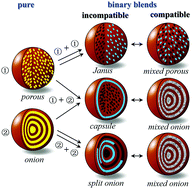当前位置:
X-MOL 学术
›
Soft Matter
›
论文详情
Our official English website, www.x-mol.net, welcomes your
feedback! (Note: you will need to create a separate account there.)
Controllable multicompartment morphologies from cooperative self-assembly of copolymer–copolymer blends
Soft Matter ( IF 2.9 ) Pub Date : 2017-07-26 00:00:00 , DOI: 10.1039/c7sm01194f Zhikun Wang 1, 2, 3, 4, 5 , Shuangqing Sun 1, 2, 3, 4, 6 , Chunling Li 1, 2, 3, 4, 6 , Songqing Hu 1, 2, 3, 4, 6 , Roland Faller 5, 7, 8, 9
Soft Matter ( IF 2.9 ) Pub Date : 2017-07-26 00:00:00 , DOI: 10.1039/c7sm01194f Zhikun Wang 1, 2, 3, 4, 5 , Shuangqing Sun 1, 2, 3, 4, 6 , Chunling Li 1, 2, 3, 4, 6 , Songqing Hu 1, 2, 3, 4, 6 , Roland Faller 5, 7, 8, 9
Affiliation

|
Multicompartment nanostructures, such as microcapsules with clearly separated shell and core, are not easily accessible by conventional block copolymer self-assembly. We assess a versatile computational strategy through cooperative assembly of diblock copolymer blends to generate spherical and cylindrical compartmentalized micelles with intricate structures and morphologies. The co-assembly strategy combines the advantages of polymer blending and incompatibility-induced phase separation. Following this strategy, various nanoassemblies of pure AB, binary AB/AC and ternary AB/AC/AD systems such as compartmentalized micelles with sponge-like, Janus, capsule-like and onion-like morphologies can be obtained. The formation and structural adjustment of microcapsule micelles, in which the shell or core can be occupied by either pure or mixed diblock copolymers, were explored. The mechanism involving the separation of shell and core copolymers is attributed to the stretching force differences of copolymers which drive the arrangement of different copolymers in a pathway to minimize the total interfacial energy. Moreover, by adjusting block interactions, an efficient approach is exhibited for regulating the shell or core composition and morphology in microcapsule micelles, such as the transition from the “pure shell/mixed core” morphology to the “mixed shell/pure core” morphology in the AB/AC/AD micelle. This mesoscale simulation study identifies the key factors governing co-assembly of diblock copolymer blends and provides bottom-up insights towards the design and optimization of new multicompartment micelles.
中文翻译:

共聚物-共聚物共混物协同自组装可控制的多室形态
常规嵌段共聚物自组装不容易获得多隔室的纳米结构,例如具有明确分离的壳和核的微胶囊。我们通过协同组装二嵌段共聚物共混物以产生具有复杂结构和形态的球形和圆柱形间隔胶束来评估一种通用的计算策略。共组装策略结合了聚合物共混和不相容性引起的相分离的优点。按照这种策略,可以获得各种纯正AB,二元AB / AC和三元AB / AC / AD系统的纳米组件,例如具有海绵状,Janus状,胶囊状和洋葱状形态的分隔胶束。微胶囊胶束的形成和结构调节 其中壳或核可以被纯的或混合的二嵌段共聚物占据。涉及壳和芯共聚物分离的机理归因于共聚物的拉伸力差异,其驱动不同共聚物在路径中的排列,以使总界面能最小化。此外,通过调节嵌段相互作用,展示了一种有效的方法来调节微胶囊胶束中的壳或核的组成和形态,例如从“纯壳/混合核”形态向“混合壳/纯核”形态的转变。 AB / AC / AD胶束。这项中等规模的模拟研究确定了决定双嵌段共聚物共混物共组装的关键因素,并为新型多室胶束的设计和优化提供了自下而上的见解。被探索了。涉及壳和芯共聚物分离的机理归因于共聚物的拉伸力差异,该差异驱动不同共聚物在路径中的排列,以使总界面能最小化。此外,通过调节嵌段相互作用,展示了一种有效的方法来调节微胶囊胶束中的壳或核组成和形态,例如从“纯壳/混合核”形态向“混合壳/纯核”形态的转变。 AB / AC / AD胶束。这项中等规模的模拟研究确定了决定双嵌段共聚物共混物共组装的关键因素,并为新型多室胶束的设计和优化提供了自下而上的见解。被探索了。涉及壳和芯共聚物分离的机理归因于共聚物的拉伸力差异,该差异驱动不同共聚物在路径中的排列,以使总界面能最小化。此外,通过调节嵌段相互作用,展示了一种有效的方法来调节微胶囊胶束中的壳或核的组成和形态,例如从“纯壳/混合核”形态向“混合壳/纯核”形态的转变。 AB / AC / AD胶束。这项中等规模的模拟研究确定了决定双嵌段共聚物共混物共组装的关键因素,并为新型多室胶束的设计和优化提供了自下而上的见解。涉及壳和芯共聚物分离的机理归因于共聚物的拉伸力差异,其驱动不同共聚物在路径中的排列,以使总界面能最小化。此外,通过调节嵌段相互作用,展示了一种有效的方法来调节微胶囊胶束中的壳或核的组成和形态,例如从“纯壳/混合核”形态向“混合壳/纯核”形态的转变。 AB / AC / AD胶束。这项中等规模的模拟研究确定了决定双嵌段共聚物共混物共组装的关键因素,并为新型多室胶束的设计和优化提供了自下而上的见解。涉及壳和芯共聚物分离的机理归因于共聚物的拉伸力差异,该差异驱动不同共聚物在路径中的排列,以使总界面能最小化。此外,通过调节嵌段相互作用,展示了一种有效的方法来调节微胶囊胶束中的壳或核的组成和形态,例如从“纯壳/混合核”形态向“混合壳/纯核”形态的转变。 AB / AC / AD胶束。这项中等规模的模拟研究确定了决定双嵌段共聚物共混物共组装的关键因素,并为新型多室胶束的设计和优化提供了自下而上的见解。
更新日期:2017-09-13
中文翻译:

共聚物-共聚物共混物协同自组装可控制的多室形态
常规嵌段共聚物自组装不容易获得多隔室的纳米结构,例如具有明确分离的壳和核的微胶囊。我们通过协同组装二嵌段共聚物共混物以产生具有复杂结构和形态的球形和圆柱形间隔胶束来评估一种通用的计算策略。共组装策略结合了聚合物共混和不相容性引起的相分离的优点。按照这种策略,可以获得各种纯正AB,二元AB / AC和三元AB / AC / AD系统的纳米组件,例如具有海绵状,Janus状,胶囊状和洋葱状形态的分隔胶束。微胶囊胶束的形成和结构调节 其中壳或核可以被纯的或混合的二嵌段共聚物占据。涉及壳和芯共聚物分离的机理归因于共聚物的拉伸力差异,其驱动不同共聚物在路径中的排列,以使总界面能最小化。此外,通过调节嵌段相互作用,展示了一种有效的方法来调节微胶囊胶束中的壳或核的组成和形态,例如从“纯壳/混合核”形态向“混合壳/纯核”形态的转变。 AB / AC / AD胶束。这项中等规模的模拟研究确定了决定双嵌段共聚物共混物共组装的关键因素,并为新型多室胶束的设计和优化提供了自下而上的见解。被探索了。涉及壳和芯共聚物分离的机理归因于共聚物的拉伸力差异,该差异驱动不同共聚物在路径中的排列,以使总界面能最小化。此外,通过调节嵌段相互作用,展示了一种有效的方法来调节微胶囊胶束中的壳或核组成和形态,例如从“纯壳/混合核”形态向“混合壳/纯核”形态的转变。 AB / AC / AD胶束。这项中等规模的模拟研究确定了决定双嵌段共聚物共混物共组装的关键因素,并为新型多室胶束的设计和优化提供了自下而上的见解。被探索了。涉及壳和芯共聚物分离的机理归因于共聚物的拉伸力差异,该差异驱动不同共聚物在路径中的排列,以使总界面能最小化。此外,通过调节嵌段相互作用,展示了一种有效的方法来调节微胶囊胶束中的壳或核的组成和形态,例如从“纯壳/混合核”形态向“混合壳/纯核”形态的转变。 AB / AC / AD胶束。这项中等规模的模拟研究确定了决定双嵌段共聚物共混物共组装的关键因素,并为新型多室胶束的设计和优化提供了自下而上的见解。涉及壳和芯共聚物分离的机理归因于共聚物的拉伸力差异,其驱动不同共聚物在路径中的排列,以使总界面能最小化。此外,通过调节嵌段相互作用,展示了一种有效的方法来调节微胶囊胶束中的壳或核的组成和形态,例如从“纯壳/混合核”形态向“混合壳/纯核”形态的转变。 AB / AC / AD胶束。这项中等规模的模拟研究确定了决定双嵌段共聚物共混物共组装的关键因素,并为新型多室胶束的设计和优化提供了自下而上的见解。涉及壳和芯共聚物分离的机理归因于共聚物的拉伸力差异,该差异驱动不同共聚物在路径中的排列,以使总界面能最小化。此外,通过调节嵌段相互作用,展示了一种有效的方法来调节微胶囊胶束中的壳或核的组成和形态,例如从“纯壳/混合核”形态向“混合壳/纯核”形态的转变。 AB / AC / AD胶束。这项中等规模的模拟研究确定了决定双嵌段共聚物共混物共组装的关键因素,并为新型多室胶束的设计和优化提供了自下而上的见解。











































 京公网安备 11010802027423号
京公网安备 11010802027423号